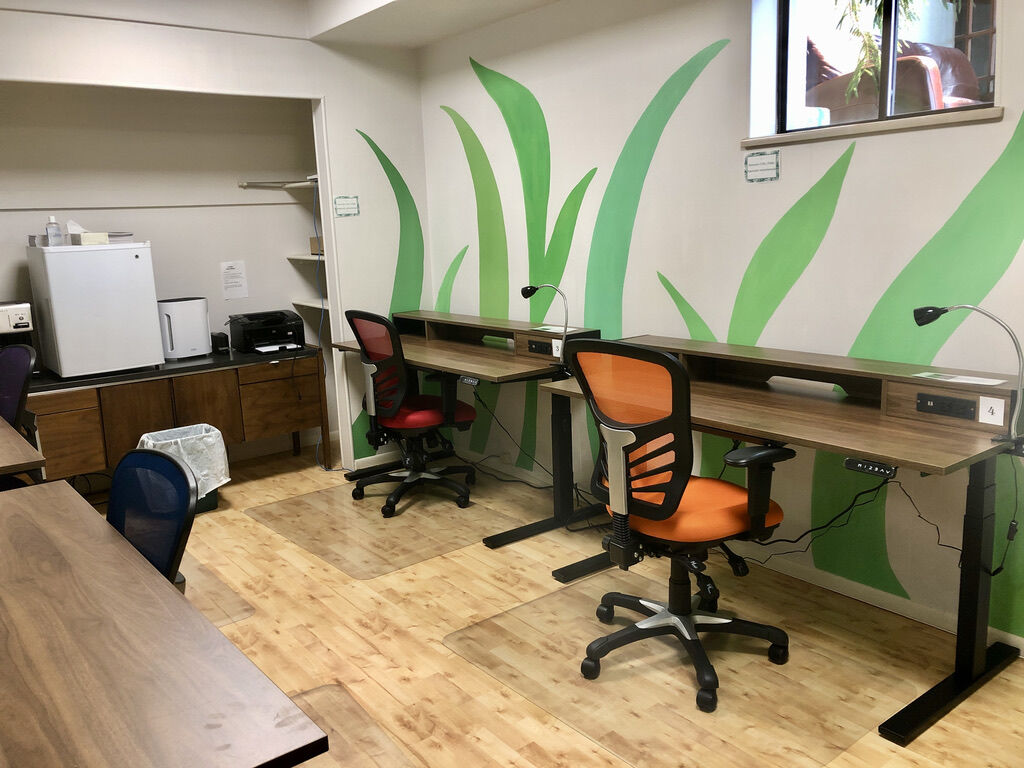Last year, the Moab Arts and Recreation Center introduced a co-working space that provided affordable, shared office space.
Makeda Barkley, then administrative assistant at the MARC, came up with the idea as a way to fill existing empty office space in the lower level of the building. Barkley suggested adding more desks and lowering the price point to make the space more casually available.
The MARC team hand-built five desks and allowed co-working space users to utilize the entire building, giving access to not only a desk but also to shared comfy couches, kitchen spaces, and the MARC’s wifi. Day passes were priced at $10/day, and monthly passes at $75.
The idea exploded in popularity.
“This building was crawling with people, which was a little crazy,” said Sascha Steinberg, the associate art director at the MARC. “It blew up.”
After seeing how popular the idea of co-working was last year, the team decided to apply for grants to enhance their space.
They’ve since received grant funding from the county and from the governor’s office. Now, the organization is planning to expand the accessibility of the space by adding new furniture, including more couches and a conference table, and creating a better system for people to reserve and get into the space. Renovations started this summer, starting with upgraded desks that feature outlets and the ability to become standing desks—although the original, hand-built desks, with lamps from WabiSabi, still remain.
Now, users have the option to reserve individual desks; work in a private room; or rent the conference room, stage room, or dance room.
Co-working spaces rose in popularity in the late 2010s, especially in cities. WeWork, a company that provides co-working spaces in over 800 locations worldwide, found in a recent study that 64% of survey-respondents said they would pay for access to an office space that wasn’t their company HQ. The survey also found that respondents wanted, on average, to spend 36% of their working time at the company HQ, 30% working from home, and 34% working from other locations.
During the COVID-19 pandemic, employees who normally worked in office spaces suddenly found themselves working from home and over Zoom. Some employees are beginning to return to the office, but work culture has definitively shifted: remote work is becoming the new normal. A 2020 study by Owl Labs found that half of survey respondents said they would not return to jobs that don’t offer remote work.
Moab didn’t have any official co-working spaces until the MARC introduced theirs. Currently, the space has a few monthly members, but most of the people who work there are day pass users, Steinberg said. She’s seen a mix of locals, seasonal residents, and vacation residents alike using the space. Many of the locals need a space to work away from their home, and find that using a desk helps them focus more. Plus, a day pass to the MARC’s co-working space—$10—is about the same cost as buying enough coffee at a coffee shop to work there all day.
The space has also allowed the MARC to capture a new audience for their events, Steinberg said. Some of the people who use the co-working space, such as seasonal remote-workers, normally wouldn’t overlap with the people who join the arts programs because they’re less likely to hear about it. But as they use the space for their co-working, they also have access to more information about events.
Renovations to the space are continuing throughout the summer and fall, Steinberg said. The MARC team still has a lot of questions on what to do with it—should they add more private rooms, or another room with desks? What spaces will be utilized the most? But ultimately, they’re determined to continue to grow.
Day passes to the co-working space are $10, and monthly passes are $75. More information on the space and how to reserve passes is available at https://www.moabarts.org/co-working-space.




